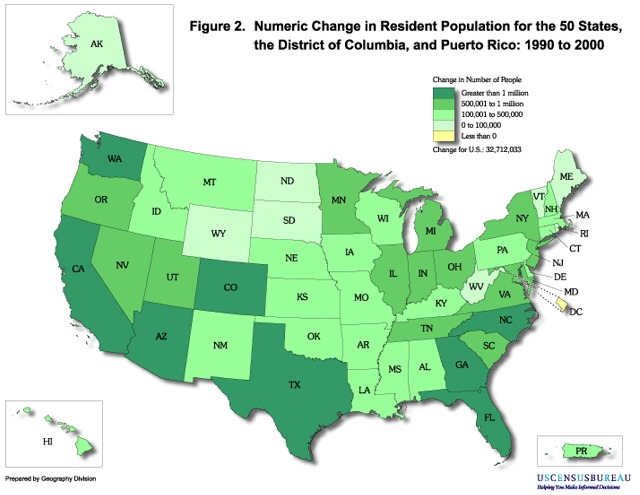United States 2000 Census
|
|
The United States 2000 Census, conducted by the Census Bureau, determined the resident population of the United States on April 1, 2000, to be 281,421,906, an increase of 13.2 percent over the 248,709,873 persons enumerated during the 1990 Census.
The U.S. resident population includes the total number of people in the 50 states and the District of Columbia. The Bureau also enumerated the residents of the Commonwealth of Puerto Rico; its population was 3,808,610, an 8.1 percent increase over the number from a decade earlier.
| Contents |
Population profile
In an introduction to a more detailed population profile (see references below), the Census Bureau highlighted the following facts about U.S population dynamics:
- 75.1 percent of respondents said they were White and no other race;
- Hispanics - who may belong to any race - accounted for 12.5 percent of the U.S. population, up from 9 percent in 1990;
- Between 1990 and 2000, the population aged 45 to 54 grew by 49 percent and those aged 85 and older grew 38 percent;
- Women outnumber men two to one among those aged 85 and older;
- Almost one in five adults had some type of disability in 1997 and the likelihood of having a disability increased with age;
- Families (as opposed to men or women living alone) still dominate American households, but less so than they did thirty years ago;
- Since 1993, both families and nonfamilies have seen median household incomes rise, with "households headed by a woman without a spouse present" growing the fastest;
- People in married-couple families have the lowest poverty rates;
- The poor of any age are more likely than others to lack health insurance coverage;
- The number of elementary and high school students in 2000 fell just short of the all-time high of 49 million reached in 1970;
- Improvements in educational attainment cross racial and ethnic lines; and
- The majority (51%) of U.S. households have access to computers; 41% have Internet access.
Population breakdown
The most-populous state in the country was California (33,871,648); the least populous was Wyoming (493,782). The state that gained the most numerically since the 1990 census was California, up 4,111,627. Nevada had the highest percentage growth in population, climbing 66.3 percent (796,424 people) since 1990.
Changes in population
Regionally, the South and West picked up the bulk of the nation's population increase, 14,790,890 and 10,411,850, respectively. This meant that the mean center of U.S. population moved to Phelps County, Missouri. The Northeast grew by 2,785,149; the Midwest, by 4,724,144.
Languages spoken at home
The Modern Language Association provides a website with overviews and detailed data about the locations and numbers of speakers of thirty languages and seven groups of less commonly spoken languages in the United States. Languages other than English are spoken at home by 46,951,595 respondents or 17.88% of people who are at least five years old. Below are the top languages spoken at home. Percentage is with respect to the number of people reported language other than English. Languages that contribute over 1% are listed.
- Spanish or Spanish Creole (60%)
- French or French Creole (4.5%)
- Chinese (4.3%)
- German (2.9%)
- Tagalog (2.6%)
- Vietnamese (2.1%)
- Italian (2.1%)
- Korean (1.9%)
- Russian (1.5%)
- Polish (1.4%)
- Arabic (1.3%)
- Portuguese or Portuguese Creole (1.2%)
- Japanese (1.0%)
Reapportionment
The results of the census are used to determine how many congressional districts each state is apportioned. Congress defines the formula, in accordance with Title 2 of the U.S. Code, to reapportion among the states the 435 seats in the United States House of Representatives. The apportionment population consists of the resident population of the fifty states, plus the overseas military and federal civilian employees and their dependents living with them who could be allocated to a state. Each member of the House represents a population of about 647,000. The populations of the District of Columbia and Puerto Rico are excluded from the apportionment population because they do not have voting seats in the U. S. House of Representatives.
Since 1790, the first census, the decennial count has been the basis for the United States representative form of government. In 1790, each member of the House represented about 34,000 residents. Since then, the House has more than quadrupled in size, and each member represents about 19 times as many constituents.

External links and references
United States Census Bureau web pages:
- Census 2000 gateway (http://www.census.gov/main/www/cen2000.html)
- Population Profile of the United States: 2000 (http://www.census.gov/population/www/pop-profile/profile2000.html)
- Population Profile Introductory slide show (http://www.census.gov/population/pop-profile/2000/profile2000.ppt), in MS Powerpoint format
- State and County QuickFacts (http://quickfacts.census.gov/qfd/), the most requested information
- American FactFinder (http://factfinder.census.gov), for population, housing, economic, and geographic data
Other 2000 census websites:
- MLA Language Map (http://www.mla.org/census_main) from the Modern Language Associationzh:美国2000年人口普查


